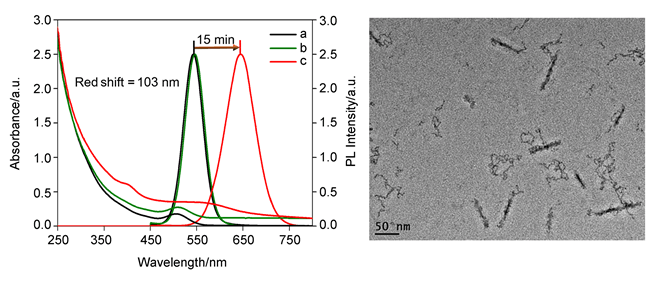| [1] Ma, N.; Sargent, E. H.; Kelley, S. O. Nat. Nanotechnol. 2009, 4, 121.
[2] Zhang, T.; Li, Z.; Sun, Q. H.; Ma, N. Chin. J. Anal. Chem. 44(12), 1840.
[3] Arshad, A.; Chen, H. L.; Bai, X. L.; Xu, S. Y.; Wang, L. Y. Chin. J. Chem. 34(6), 576.
[4] Jiang, C.; Shen, Z.; Luo, C.; Lin, H.; Huang, Y.; Wang, Y.; Peng, H. Talanta 2016, 155, 14.
[5] Huang, L.; Li, Z. C.; Huang, S. Q.; Peter, R.; Li, L. Acta Chim. Sinica 2017, 75, 300. (黄璐, 李志春, 黄寿强, Peter Reiss, 李良, 化学学报, 2017, 75, 300.)
[6] Shao, Y. B.; Yue, J. L.; Sun, S.; Xia, H. Chin. J. Chem. 2017, 35(1), 73.
[7] Cai, P.; Jia, Y.; Feng, X. Y.; Li, J.; Li, J. B. Chin. J. Chem. 2017, 35(6), 881.
[8] Kong, L. J.; Zhou, X. Y.; Fan, S. Y.; Li, Z. J.; Gu, Z. G. Acta Chim. Sinica 2016, 74, 620. (孔丽娟, 周晓燕, 范赛英, 李在均, 顾志国, 化学学报, 2016, 74, 620.)
[9] Dwarakanath, S.; Bruno, J. G.; Shastry, A.; Phillips, T.; John, A.; Kumar, A.; Stephenson, L. D. Biochem. Biophys. Res. Commun. 2004, 325, 739.
[10] Jaiswal, J. K.; Mattoussi, H.; Mauro, J. M.; Simon, S. M. Nat. Biotechnol. 2003, 21, 47.
[11] Wei, W.; He, X. W.; Ma, N. Angew. Chem., Int. Ed. 2014, 53, 5573.
[12] He, X. W.; Gao, L.; Ma, N. Sci. Rep. 2013, 3, 2825.
[13] Manzoor, K.; Johny, S.; Thomas, D.; Setua, S.; Menon, D.; Nair, S. Nat. Nanotechnol. 2009, 20, 065102.
[14] Michalet, X.; Pinaud, F. F.; Bentolila, L. A.; Tsay, J. M.; Doose, S.; Li, J. J.; Sundaresan, G.; Wu, A. M.; Gambhir, S. S.; Weiss, S. Science 2005, 307, 538.
[15] Medintz, I. L.; Uyeda, H. T.; Goldman, E. R.; Mattoussi, H. Nat. Mater. 2005, 4, 435.
[16] Bagalkot, V.; Zhang, L.; Levy-Nissenbaum, E.; Jon, S. Y.; Kantoff, P.; Langer, R.; Farokhzad, O. C. Nano Lett. 2007, 7, 3065.
[17] Murray, C. B.; Kagan, C. R.; Bawendi, M. G. Annu. Rev. Mater. Sci. 2000, 30, 545.
[18] Burda, C.; Chen, X. B.; Narayanan, R.; EI-Sayed, M. A. Chem. Rev. 2005, 105, 1025.
[19] Grzelczak, M.; Vermant, J.; Furst, E. M.; Liz-Marzan, L. M. ACS Nano 2010, 4, 3591.
[20] Jones, M. R.; Osberg, K. D.; Macfarlane, R. J.; Langille, M. R.; Mirkin, C. A. Chem. Rev. 2011, 111, 3736.
[21] Deng, D.; Qu, L.; Li, Y.; Gu, Y. Langmuir 2013, 29, 10907.
[22] Chen, H.; Liu, Y.; Lu, Y.; Wu, H.; Qian, H. J. Mater. Sci. 2014, 49, 4506.
[23] An, L. M.; Yang, Y. Q.; Su, W. H.; Yi, J.; Liu, C. X.; Chao, K. F.; Zeng, Q. H. J. Nanosci. Nanotechnol. 2010, 10, 2099.
[24] Yue, D.; Qian, X.; Zhang, Z.; Kan, M.; Ren, M.; Zhao, Y. ACS Sustainable Chem. Eng. 2016, 4, 6653.
[25] Zhang, C. L.; Ding, C. P.; Xiang, D. S.; Li, L.; Ji, X. H.; He, Z. K.; Xian, Y. Z. Chin. J. Chem. 2016, 34(3), 317.
[26] Li, Z.; He, X. W.; Luo, X. C.; Wang, L.; Ma, N. Anal. Chem. 2016, 88, 9355.
[27] Sapsford, K. E.; Pons, T.; Medintz, I. L.; Higashiya, S.; Brunel, F. M.; Dawson, P. E.; Mattoussi, H. J. Phys. Chem. C 2007, 111, 11528.
[28] Ji, X. B.; Yao, C. G.; Wan, Y.; Song, H. X.; Xin, P.; Cui, H. D.; Zheng, C. Y.; Deng, S. Y. Chin. J. Chem. 2016, 34(3), 331.
[29] Guo, Y.; Hu, Y.; Deng, Z. Chin. J. Chem. 2016, 34(3), 259.
[30] Huang, H.; Du, C.; Shi, H.; Feng, X.; Li, J.; Tan, Y.; Song, W. Part. Part. Syst. Char. 2015, 32, 72.
[31] Chai, Y. M.; Zhao, H. J.; Liu, Y. Q.; Liu, C. G. Inorg. Chem. Ind. 2007, 39, 12. |
